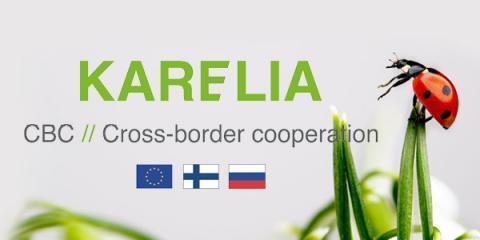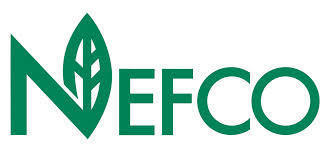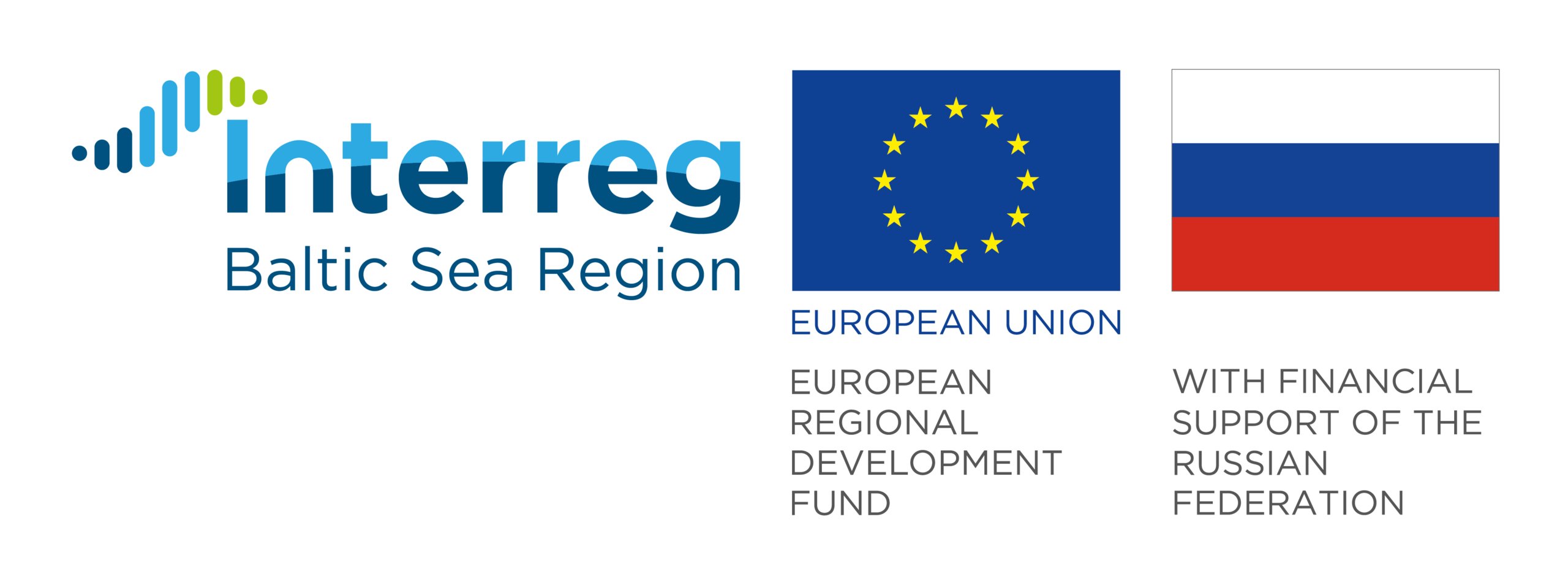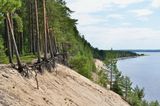Green Solutions for Nature Protected Areas (KA5043)

In October 2018 project KA5043 - Green solutions for nature protected areas was launched in the framework of cross-border cooperation programme Karelia.
Nature Protected Areas (PAs) in Finland and Karelia are as a rule located far from major cities and settlements so heat and electricity supply as well as waste collection and utilization pose a significant common problem for partners on both sides of the border.
On the other hand it is evident that we should not increase the burden on the nature by means of burning of fossil fuels, such as diesel, petrol, natural gas or coal for heat and electric power generation.
The key idea behind the project “Green Solutions for Nature Protected Areas” is to introduce modern “green” technologies at PA infrastructure objects (guest houses, visit centers, office buildings, cafes, etc):
- The use of solar panels for generating electricity (both main and backup supplies);
- The use of heat pumps for heating up PA premises,
- Construction plans for new objects (guest houses) based on modern energy saving and efficiency requirements;
- Introduction of separate waste collection, proper utilization techniques and the use of waste as raw material.
The partners undertaking to achieve the abovementioned objectives are:
- The lead partner - Autonomous no-profit organisation Energy Efficiency Centre (ANO EEC), an NGO whose main goals of are the development and implementation of international projects based on the attracted funds, grants and investment to the Republic of Karelia.
- Metsähallitus, State Forest Enterprise, provides natural resources sector services to a diverse customer base, from private individuals to major companies. Its operations are based on the knowledgeable and co-operative use of state land and water areas. Parks & Wildlife Finland (former Natural Heritage Services) is a unit of state-owned enterprise Metsähallitus. Parks & Wildlife Finland is in charge of public administration services which include: nature conservation, facilities and services for outdoor recreation, hunting and fishing services, protected area management planning. Metsähallitus protects and manages species, habitats and cultural heritage in state-owned protected areas and provides outdoor recreation services for hikers, hunters and fishers and grant land use permits.
- The Federal State Budgetary Institution "Vodlozersky National Park"
- The Federal State Budgetary Institution "Kivach State Nature Reserve"
- Nature Reserve Kostomukshsky
- Oulun Energia OY is one of the most advanced companies in Finland working in the field of green energy development and introduction. Transfer of know-how, training and consultations provided for PAs will the be the main responsibility of the OE during the project implementation.
Why do we need Finnish partners?
There are not so many cases of alternative energy use in Karelia so far. In particular, the use of solar energy and heat pumps can be found very seldom – major alternative energy supply objects are located only in Petrozavodsk. Finnish know-how is absolutely necessary for the project implementation due to the fact the various types of alternative energy technologies and objects could be found in Finland in many more places. Thus, the project should use and adopt Finnish experience during the selection of proper technologies and methods of heat and power supply and also during the pilot infrastructural project implementation. The pilot cases developed jointly by the project partners could be used as demonstration of the best practices for many other Protected Areas in Russia and Finland. In addition, it is worth to mention that Karelia has no positive experience in waste disposal and utilization in remote areas and, therefore, Finnish experience in this field is extremely important also.

Project results
 Based on the main goal of the project - to ensure a comfortable and safe stay of guests and employees in the nature protected areas of Karelia and Finland, a lot of "pilot" infrastructure projects were implemented from May to September 2019. In fact, the pilot projects consisted of selecting several objects in the nature protected areas that need electricity and heat energy, and purchasing, installing and putting into operation the equipment for solar power plants and heat pumps.
Based on the main goal of the project - to ensure a comfortable and safe stay of guests and employees in the nature protected areas of Karelia and Finland, a lot of "pilot" infrastructure projects were implemented from May to September 2019. In fact, the pilot projects consisted of selecting several objects in the nature protected areas that need electricity and heat energy, and purchasing, installing and putting into operation the equipment for solar power plants and heat pumps.
It should be noted that on the territory of the Vodlozersky NP and the Kivach NR, the objects differed in their needs: in the Vodlozersky National Park, autonomous power supply systems were required (there are no power lines at all), and in the Kivach reserve, a "hybrid system" was needed to provide electricity to expensive weather station equipment at times of power outages, which happened and happens quite often, almost daily. The use of different approaches to power supply has allowed us to expand the range of equipment used for solar power stations (SES), which now gives the project the opportunity to demonstrate various options for using solar energy to generate electricity.
Info: What is a grid-based, autonomous, and hybrid solar power plant?
1. The grid power plant directly supplies electricity to the facility as long as there is solar power. In the absence of consumers (i.e., when all or part of the devices are disabled), a grid power station makes it possible to send excess electricity directly to the electricity network, i.e. sell excess electricity to electricity supplier companies. Batteries are not required.
2. An autonomous power plant makes it possible to use solar energy by supplying a load to the network of a house / apartment, etc., as well as accumulate electricity in batteries for use in the absence of the sun.
3. A hybrid station is a combination of a network and an autonomous power plant. As a rule, it has much greater capabilities and can work both as a network and as an autonomous one, but it can also work in the mode of mixing electricity into the network. For example: if the facility requires supply of 3 kW, but no more than 0.5 kW of solar energy is generated, the inverter receives 0.5 kW from solar modules / panels, and adds the missing 2.5 kW from electricity network.
Pilot projects in Vodlozersky NP
1. Solar power stations at tourist bases Novguda and Ohtoma
 Autonomous solar power plants with the same set of equipment have been installed and are already operating on the tourist bases of Novguda and Ohtoma (see the map on the left). The stations are designed so that during daylight hours they must fully provide electricity to the tourist bases (lightning, communication, electric kettle, charging phones, powering the batteries, etc.). In addition, solar power stations are connected to gasoline generators, so that in the case of a full discharge of the batteries (winter night), the generator could be used as a backup source of electricity, and not the main one as it was before.
Autonomous solar power plants with the same set of equipment have been installed and are already operating on the tourist bases of Novguda and Ohtoma (see the map on the left). The stations are designed so that during daylight hours they must fully provide electricity to the tourist bases (lightning, communication, electric kettle, charging phones, powering the batteries, etc.). In addition, solar power stations are connected to gasoline generators, so that in the case of a full discharge of the batteries (winter night), the generator could be used as a backup source of electricity, and not the main one as it was before.
Solar power station equipment sets at tourist bases:
- 8 solar panels х 250 W (polycrystalline, serial connection)
- 6 batteries of 200 А*h, total capacity of 1200 А*h
- Invertor SILA 3000 W х24 V
Efficiency:
At full load (3 kW), solar power stations can operate autonomously for up to 2 hours. With a load of about 100 -150 W (for example, house lightning), stations can operate autonomously for up to 60 hours without turning on gasoline generators. This way, gasoline is saved, there are no emissions of combustion products, there is no need to store large stocks of fuel, and the cost of buying and delivering fuel to the tourist bases is reduced.
2. A heat pump in a visit centre in Kuganavolok settlement
 In the visit centre on the territory of the national park estate an air-ti-air heat pump Electrolux EACS/I-18 HVI/N3 – 5/5.5 kW was installed in April 2019.
In the visit centre on the territory of the national park estate an air-ti-air heat pump Electrolux EACS/I-18 HVI/N3 – 5/5.5 kW was installed in April 2019.
Efficiency: consuming 1.5 kW of electricity, the heat pump generates up to 5.3 kW of heat when it's over -10° outside. This amount of heat is sufficient for heating up a 50 m2 cafeteria even in winter.
Pilot projects in Kivach NR
1. A heat pump in the cafeteria
In "Sedoy Kivach" cafeteria that is always full of tourists a heat pump Electrolux EACS/I-18 HVI/N3 – 5/5.5 kW was installed in July 2019. In autumn and winter, at temperatures just below zero, this cafeteria, with the room of about 40m2, was completely heated by a heat pump. The process of controlling this device via a remote control panel is no different from the familiar conventional household air conditioner.
2. Hybrid solar power station
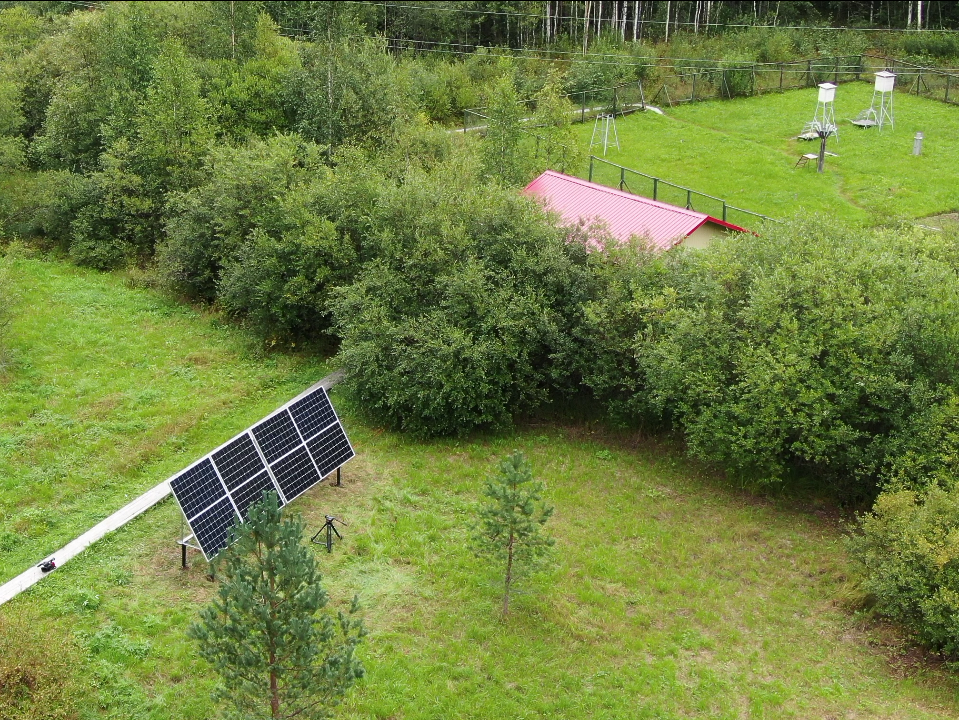 In August 2019, a hybrid solar power station with a maximum power of 3000W was installed in the reserve (near the meteostation). The main task of the solar power station is to ensure uninterrupted power supply to the weather station and other consumers / objects located nearby. The maximum power consumed by the weather station in winter is about 1500W.
In August 2019, a hybrid solar power station with a maximum power of 3000W was installed in the reserve (near the meteostation). The main task of the solar power station is to ensure uninterrupted power supply to the weather station and other consumers / objects located nearby. The maximum power consumed by the weather station in winter is about 1500W.
Solar power station equipment set:
- 8 solar panels х 300 W
- 4 batteries of 200 А*h, total capacity of 800 А*h
- Invertor SILA 3000 W
Efficiency: during power outage, solar power station is capable of autonomous operation for up to 2 hours on solar power (from daylight) and battery charge (hight time).
Pilot projects at Ärjänsaari island, lake Oulujarvi (Kainuu region)
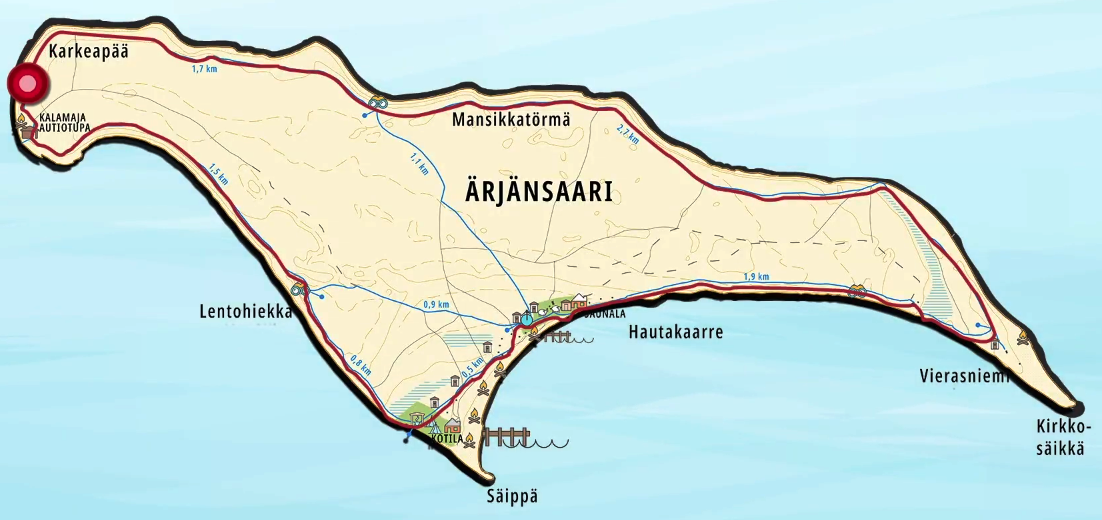
Video presentation of Ärjänsaari island
1. Kotila cottage
This small cottage was was built in 1937 and was previously used as a summer house. It is of historical value and was renovated in 2019, now serving as a summer cafe.
Solar power station equipment set:
- 9 solar panels х 300 W
- 4 batteries of 250 А*h/ 12 V,
- Invertor Easysolar 5000 х 48V
2. Summer kitchen
It is a small wooden shelter with a stove and a grill built in 1960s. This is a place for cooking food and having meals accessible for all visitors. Restoration of all wooden construction parts is planned.
Solar power station (for charging mobile devices):
- Solar panels: 1 x 300 W,
- Battery: 1 x 12V х 100А*h (no invertor)
3. Saunala cottage
Build in 1952, previously used as a summer house. A protected building. Renovated in 2019 as a sheperd's house. It has full set of kitchen appliances including a coffee maker, kettle and a fridge.
Solar power station equipment set:
- Solar panels: 6 x 300W,
- Batteries: 2 x 12V х 250А*h,
- Invertor: Easysolar 3000 х 24V
4. Vierasmaja cottage
Built in 1951. It was used as a primary (VIP) accommodation of the management and visitors of the forest company that used to own the island. At present, the plans are to rent it out to tourist. A protected building.
Solar power station equipment set:
- Solar panels: 4 x 300 W
- Batteries: 2 x 12 V х 250 А*h
- Inventor: Easysolar 3000 х 24 V
Therefore, both Finnish and Russian partners have invested a lot of effort and money in 2019 to implement "green" technologies for generating electricity at their facilities. This useful and interesting work continued in 2020. This year, we will try out another technology for generating energy from solar radiation - solar vacuum collectors. Solar collector is the most effective method of heating water, which is used in heating and hot water supply systems of houses in terms of payback and efficiency. Vodlozersky NP and Kivach NR are ready to apply this technology at their premises.
Pilot project implementation results
Please see subtitles for all information
